11 Nomenclature and Design
Nomenclature and Design
802.11 networks consist of four major physical components, which are summarized in Figure 2-3.
Figure 2-3. Components of 802.11 LANs
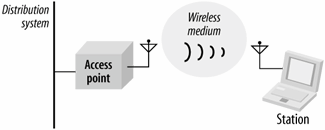
The components are:
Stations
Networks are built to transfer data between stations. Stations are computing devices with wireless network interfaces. Typically, stations are battery-operated laptop or handheld computers. There is no reason why stations must be portable computing devices, though. In some environments, wireless networking is used to avoid pulling new cable, and desktops are connected by wireless LANs. Large open areas may also benefit from wireless networking, such as a manufacturing floor using a wireless LAN to connect components. 802.11 is fast becoming a de facto standard for linking together consumer electronics. Apple's AirPort Express connects computers to stereos via 802.11. TiVos can connect to wireless networks. Several consumer electronics companies have joined the 802.11 working group, apparently with the intent of enabling high-speed media transfers over 802.11.
Access points
Frames on an 802.11 network must be converted to another type of frame for delivery to the rest of the world. Devices called access points perform the wireless-to-wired bridging function. (Access points perform a number of other functions, but bridging is by far the most important.) Initially, access point functions were put into standalone devices, though several newer products are dividing the 802.11 protocol between "thin" access points and AP controllers.
Wireless medium
To move frames from station to station, the standard uses a wireless medium. Several different physical layers are defined; the architecture allows multiple physical layers to be developed to support the 802.11 MAC. Initially, two radio frequency (RF) physical layers and one infrared physical layer were standardized, though the RF layers have proven far more popular. Several additional RF layers have been standardized as well.
Distribution system
When several access points are connected to form a large coverage area, they must communicate with each other to track the movements of mobile stations. The distribution system is the logical component of 802.11 used to forward frames to their destination. 802.11 does not specify any particular technology for the distribution system. In most commercial products, the distribution system is implemented as a combination of a bridging engine and a distribution system medium, which is the backbone network used to relay frames between access points; it is often called simply the backbone network. In nearly all commercially successful products, Ethernet is used as the backbone network technology.
Types of Networks
The basic building block of an 802.11 network is the basic service set (BSS), which is simply a group of stations that communicate with each other. Communications take place within a somewhat fuzzy area, called the basic service area, defined by the propagation characteristics of the wireless medium.[*] When a station is in the basic service area, it can communicate with the other members of the BSS. BSSs come in two flavors, both of which are illustrated in Figure 2-4.
[*] All of the wireless media used will propagate in three dimensions. From that perspective, the service area should perhaps be called the service volume. However, the term area is widely used and accepted.
Figure 2-4. Independent and infrastructure BSSs
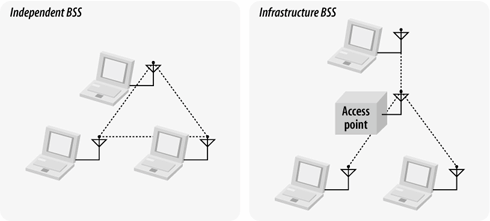
Independent networks
On the left is an independent BSS (IBSS). Stations in an IBSS communicate directly with each other and thus must be within direct communication range. The smallest possible 802.11 network is an IBSS with two stations. Typically, IBSSs are composed of a small number of stations set up for a specific purpose and for a short period of time. One common use is to create a short-lived network to support a single meeting in a conference room. As the meeting begins, the participants create an IBSS to share data. When the meeting ends, the IBSS is dissolved.[ ] Due to their short duration, small size, and focused purpose, IBSSs are sometimes referred to as ad hoc networks.
] Due to their short duration, small size, and focused purpose, IBSSs are sometimes referred to as ad hoc networks.
[
images/ent/U2020.GIF border=0>] IBSSs have found a similar use at LAN parties throughout the world.
Infrastructure networks
On the right side of Figure 2-4 is an infrastructure BSS. (To avoid overloading the acronym, an infrastructure BSS is never called an IBSS). Infrastructure networks are distinguished by the use of an access point. Access points are used for all communications in infrastructure networks, including communication between mobile nodes in the same service area. If one mobile station in an infrastructure BSS needs to communicate with a second mobile station, the communication must take two hops. First, the originating mobile station transfers the frame to the access point. Second, the access point transfers the frame to the destination station. With all communications relayed through an access point, the basic service area corresponding to an infrastructure BSS is defined by the points in which transmissions from the access point can be received. Although the multihop transmission takes more transmission capacity than a directed frame from the sender to the receiver, it has two major advantages:
- An infrastructure BSS is defined by the distance from the access point. All mobile stations are required to be within reach of the access point, but no restriction is placed on the distance between mobile stations themselves. Allowing direct communication between mobile stations would save transmission capacity but at the cost of increased physical layer complexity because mobile stations would need to maintain neighbor relationships with all other mobile stations within the service area.
- Access points in infrastructure networks are in a position to assist with stations attempting to save power. Access points can note when a station enters a power-saving mode and buffer frames for it. Battery-operated stations can turn the wireless transceiver off and power it up only to transmit and retrieve buffered frames from the access point.
In an infrastructure network, stations must associate with an access point to obtain network services. Association is the process by which mobile station joins an 802.11 network; it is logically equivalent to plugging in the network cable on an Ethernet. It is not a symmetric process. Mobile stations always initiate the association process, and access points may choose to grant or deny access based on the contents of an association request. Associations are also exclusive on the part of the mobile station: a mobile station can be associated with only one access point.[*] The 802.11 standard places no limit on the number of mobile stations that an access point may serve. Implementation considerations may, of course, limit the number of mobile stations an access point may serve. In practice, however, the relatively low throughput of wireless networks is far more likely to limit the number of stations placed on a wireless network.
[*] One reviewer noted that a similar restriction was present in traditional Ethernet networks until the development of VLANs and specifically asked how long this restriction was likely to last. I am not intimately involved with the standardization work, so I cannot speak to the issue directly. I do, however, agree that it is an interesting question.
Extended service areas
BSSs can create coverage in small offices and homes, but they cannot provide network coverage to larger areas. 802.11 allows wireless networks of arbitrarily large size to be created by linking BSSs into an extended service set (ESS). An ESS is created by chaining BSSs together with a backbone network. All the access points in an ESS are given the same service set identifier (SSID), which serves as a network "name" for the users.
802.11 does not specify a particular backbone technology; it requires only that the backbone provide a specified set of services. In Figure 2-5, the ESS is the union of the four BSSs (provided that all the access points are configured to be part of the same ESS). In real-world deployments, the degree of overlap between the BSSs would probably be much greater than the overlap in Figure 2-5. In real life, you would want to offer continuous coverage within the extended service area; you wouldn't want to require that users walk through the area covered by BSS3 when en route from BSS1 to BSS2.
Figure 2-5. Extended service set
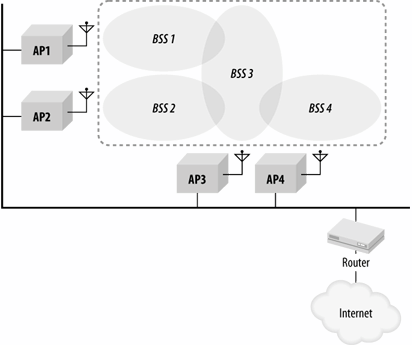
Stations within the same ESS may communicate with each other, even though these stations may be in different basic service areas and may even be moving between basic service areas. For stations in an ESS to communicate with each other, the wireless medium must act like a single layer 2 connection. Access points act as bridges, so direct communication between stations in an ESS requires that the backbone network also look like a layer 2 connection. First-generation access points required direct layer 2 connections through hubs or virtual LANs; newer products implement a variety of tunneling technologies to emulate the layer 2 environment.
|
Extended service areas are the highest-level abstraction supported by 802.11 networks. Access points in an ESS operate in concert to allow the outside world to use the station's MAC address to talk to a station no matter what its location is within the ESS. In Figure 2-5, the router uses the station's MAC address as the destination to deliver frames to a mobile station; only the access point with which that mobile station is associated delivers the frame. The router remains ignorant of the location of the mobile station and relies on the access points to deliver the frame.
Multi-BSS environments: "virtual APs"
Early 802.11 radio chips had the ability to create a single basic service set. An AP could have connect users to only one "wireless network," and all users on that network had similar, if not identical, privileges. In early deployments with limited user counts, a single logical network was sufficient. As wireless networking grew in popularity, one network no longer sufficed.
As an example, most organizations get regular visitors, many of whom have 802.11 equipment and need (or strongly desire) Internet access. Guests are not trusted users. One common way of coping with guest access is to create two extended service sets on the same physical infrastructure. Current 802.11 chipsets can create multiple networks with the same radio. Using modern chipsets, each access point hardware device can create two BSSs, one for the network named guest, and one for the network named internal. Within the AP, each SSIDs is associated with a VLAN. The guest network is connected to a VLAN prepared for public access by unknown and untrusted users, and is almost certainly attached outside the firewall.
Wireless devices see two separate networks in the radio domain, and can connect to whatever one suits their needs. (Naturally, the internal network is probably protected by authentication prevent unauthorized use.) Users who connect to the wireless network named guest will be placed on the guest VLAN, while users who connect to the wireless network named internal will be authenticated and placed on the internal network.
This somewhat contrived example illustrates the development of what many call virtual access points. Each BSS acts like its own self-contained AP, with its own ESSID, MAC address, authentication configuration, and encryption settings. Virtual APs are also used to create parallel networks with different security levels, a configuration that will be discussed in Chapter 22. Current 802.11 radio chipsets have the ability to create 32 or even 64 BSSes, which is adequate for nearly every configuration.
Robust security networks (RSNs)
Early wireless LANs proved to have feeble built-in security. 802.11i, which was ratified in June 2004, specifies a set of improved security mechanisms that provide robust security network associations (RSNAs). Robust security network associations are formed when improved the authentication and confidentiality protocols defined in 802.11i are in use. Support for 802.11i may be composed of hardware, software, or both, depending on the exact architecture of a particular device. Hardware which does not support the improved protocols is referred to as pre-RSN capable. Many recent pre-RSN capable devices may be upgradeable to support 802.11i, but most older devices will not be upgradeable.
The Distribution System, Revisited
With an understanding of how an extended service set is built, I'd like to return to the concept of the distribution system. 802.11 describes the distribution system in terms of the services it provides to wireless stations. While these services will be described in more detail later in this chapter, it is worth describing their operation at a high level. The distribution system provides mobility by connecting access points. When a frame is given to the distribution system, it is delivered to the right access point and relayed by that access point to the intended destination.
The distribution system is responsible for tracking where a station is physically located and delivering frames appropriately. When a frame is sent to a mobile station, the distribution system is charged with the task of delivering it to the access point serving the mobile station. As an example, consider the router in Figure 2-5. The router simply uses the MAC address of a mobile station as its destination. The distribution system of the ESS pictured in Figure 2-5 must deliver the frame to the right access point. Obviously, part of the delivery mechanism is the backbone Ethernet, but the backbone network cannot be the entire distribution system because it has no way of choosing between access points. In the language of 802.11, the backbone Ethernet is the distribution system medium, but it is not the entire distribution system.
To find the rest of the distribution system, we need to look to the access points themselves. Most access points currently on the market operate as bridges. They have at least one wireless network interface and at least one Ethernet network interface. The Ethernet side can be connected to an existing network, and the wireless side becomes an extension of that network. Relaying frames between the two network media is controlled by a bridging engine.
Figure 2-6 illustrates the relationship between the access point, the backbone network, and the distribution system. The access point has two interfaces connected by a bridging engine. Arrows indicate the potential paths to and from the bridging engine. Frames may be sent by the bridge to the wireless network; any frames sent by the bridge's wireless port are transmitted to all associated stations. Each associated station can transmit frames to the access point. Finally, the backbone port on the bridge can interact directly with the backbone network. The distribution system in Figure 2-6 is composed of the bridging engine plus the wired backbone network.
Figure 2-6. Distribution system in common 802.11 access point implementations

Every frame sent by a mobile station in an infrastructure network must use the distribution system. It is easy to understand why interaction with hosts on the backbone network must use the distribution system. After all, they are connected to the distribution system medium. Wireless stations in an infrastructure network depend on the distribution system to communicate with each other because they are not directly connected to each other. The only way for station A to send a frame to station B is by relaying the frame through the bridging engine in the access point. However, the bridge is a component of the distribution system. While what exactly makes up the distribution system may seem like a narrow technical concern, there are some features of the 802.11 MAC that are closely tied to its interaction with the distribution system.
Interaccess point communication as part of the distribution system
Included with this distribution system is a method to manage associations. A wireless station is associated with only one access point at a time. If a station is associated with one access point, all the other access points in the ESS need to learn about that station. In Figure 2-5, AP4 must know about all the stations associated with AP1. If a wireless station associated with AP4 sends a frame to a station associated with AP1, the bridging engine inside AP4 must send the frame over the backbone Ethernet to AP1 so it can be delivered to its ultimate destination. To fully implement the distribution system, access points must inform other access points of associated stations. Naturally, many access points on the market use an interaccess point protocol (IAPP) over the backbone medium. Many vendors developed proprietary protocols between access points to carry association data. A standard IAPP was produced as 802.11F, but I am not aware of its use in any products.
Wireless bridges and the distribution system
Up to this point, I have tacitly assumed that the distribution system medium was an existing fixed network. While this will often be the case, the 802.11 specification explicitly supports using the wireless medium itself as the distribution system. The wireless distribution system (WDS) configuration is often called a "wireless bridge" configuration because it allows network engineers to connect two LANs at the link layer. Wireless bridges can be used to quickly connect distinct physical locations and are well-suited for use by access providers. Most 802.11 access points on the market now support the wireless bridge configuration, though it may be necessary to upgrade the firmware on older units.
Network Boundaries
Because of the nature of the wireless medium, 802.11 networks have fuzzy boundaries. In fact, some degree of fuzziness is desirable. As with mobile telephone networks, allowing basic service areas to overlap increases the probability of successful transitions between basic service areas and offers the highest level of network coverage. The basic service areas on the right of Figure 2-7 overlap significantly. This means that a station moving from BSS2 to BSS4 is not likely to lose coverage; it also means that AP3 (or, for that matter, AP4) can fail without compromising the network too badly. On the other hand, if AP2 fails, the network is cut into two disjoint parts, and stations in BSS1 lose connectivity when moving out of BSS1 and into BSS3 or BSS4. Coping with "coverage holes" from access point failures is a task that requires attention during the network design phase; many newer products offer dynamic radio tuning capabilities to automatically fill in holes that develop during network operation.
Figure 2-7. Overlapping BSSs in an ESS
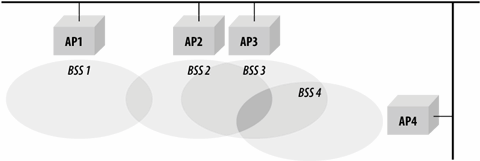
Different types of 802.11 networks may also overlap. Independent BSSs may be created within the basic service area of an access point. Figure 2-8 illustrates spatial overlap. An access point appears at the top of the figure; its basic service area is shaded. Two stations are operating in infrastructure mode and communicate only with the access point. Three stations have been set up as an independent BSS and communicate with each other. Although the five stations are assigned to two different BSSs, they may share the same wireless medium. Stations may obtain access to the medium only by using the rules specified in the 802.11 MAC; these rules were carefully designed to enable multiple 802.11 networks to coexist in the same spatial area. Both BSSs must share the capacity of a single radio channel, so there may be adverse performance implications from co-located BSSs.
Figure 2-8. Overlapping network types
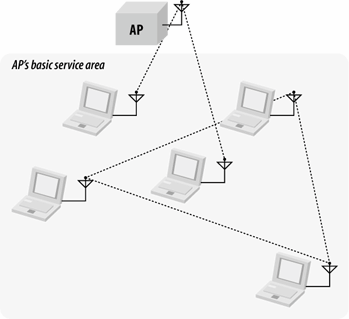
Introduction to Wireless Networking
- Introduction to Wireless Networking
- Why Wireless?
- What Makes Wireless Networks Different
- A Network by Any Other Name...
Overview of 802.11 Networks
- Overview of 802.11 Networks
- IEEE 802 Network Technology Family Tree
- 11 Nomenclature and Design
- 11 Network Operations
- Mobility Support
11 MAC Fundamentals
- 11 MAC Fundamentals
- Challenges for the MAC
- MAC Access Modes and Timing
- Contention-Based Access Using the DCF
- Fragmentation and Reassembly
- Frame Format
- Encapsulation of Higher-Layer Protocols Within 802.11
- Contention-Based Data Service
- Frame Processing and Bridging
11 Framing in Detail
- 11 Framing in Detail
- Data Frames
- Control Frames
- Management Frames
- Frame Transmission and Association and Authentication States
Wired Equivalent Privacy (WEP)
- Wired Equivalent Privacy (WEP)
- Cryptographic Background to WEP
- WEP Cryptographic Operations
- Problems with WEP
- Dynamic WEP
User Authentication with 802.1X
- User Authentication with 802.1X
- The Extensible Authentication Protocol
- EAP Methods
- 1X: Network Port Authentication
- 1X on Wireless LANs
11i: Robust Security Networks, TKIP, and CCMP
- 11i: Robust Security Networks, TKIP, and CCMP
- The Temporal Key Integrity Protocol (TKIP)
- Counter Mode with CBC-MAC (CCMP)
- Robust Security Network (RSN) Operations
Management Operations
- Management Operations
- Management Architecture
- Scanning
- Authentication
- Preauthentication
- Association
- Power Conservation
- Timer Synchronization
- Spectrum Management
Contention-Free Service with the PCF
- Contention-Free Service with the PCF
- Contention-Free Access Using the PCF
- Detailed PCF Framing
- Power Management and the PCF
Physical Layer Overview
- Physical Layer Overview
- Physical-Layer Architecture
- The Radio Link
- RF Propagation with 802.11
- RF Engineering for 802.11
The Frequency-Hopping (FH) PHY
- The Frequency-Hopping (FH) PHY
- Frequency-Hopping Transmission
- Gaussian Frequency Shift Keying (GFSK)
- FH PHY Convergence Procedure (PLCP)
- Frequency-Hopping PMD Sublayer
- Characteristics of the FH PHY
The Direct Sequence PHYs: DSSS and HR/DSSS (802.11b)
- The Direct Sequence PHYs: DSSS and HR/DSSS (802.11b)
- Direct Sequence Transmission
- Differential Phase Shift Keying (DPSK)
- The Original Direct Sequence PHY
- Complementary Code Keying
- High Rate Direct Sequence PHY
11a and 802.11j: 5-GHz OFDM PHY
- 11a and 802.11j: 5-GHz OFDM PHY
- Orthogonal Frequency Division Multiplexing (OFDM)
- OFDM as Applied by 802.11a
- OFDM PLCP
- OFDM PMD
- Characteristics of the OFDM PHY
11g: The Extended-Rate PHY (ERP)
- 11g: The Extended-Rate PHY (ERP)
- 11g Components
- ERP Physical Layer Convergence (PLCP)
- ERP Physical Medium Dependent (PMD) Layer
A Peek Ahead at 802.11n: MIMO-OFDM
11 Hardware
- 11 Hardware
- General Structure of an 802.11 Interface
- Implementation-Specific Behavior
- Reading the Specification Sheet
Using 802.11 on Windows
11 on the Macintosh
Using 802.11 on Linux
- Using 802.11 on Linux
- PCMCIA Support on Linux
- Linux Wireless Extensions and Tools
- Agere (Lucent) Orinoco
- Atheros-Based cards and MADwifi
- 1X on Linux with xsupplicant
Using 802.11 Access Points
- Using 802.11 Access Points
- General Functions of an Access Point
- Power over Ethernet (PoE)
- Selecting Access Points
- Cisco 1200 Access Point
- Apple AirPort
Logical Wireless Network Architecture
- Logical Wireless Network Architecture
- Evaluating a Logical Architecture
- Topology Examples
- Choosing Your Logical Architecture
Security Architecture
- Security Architecture
- Security Definition and Analysis
- Authentication and Access Control
- Ensuring Secrecy Through Encryption
- Selecting Security Protocols
- Rogue Access Points
Site Planning and Project Management
- Site Planning and Project Management
- Project Planning and Requirements
- Network Requirements
- Physical Layer Selection and Design
- Planning Access-Point Placement
- Using Antennas to Tailor Coverage
11 Network Analysis
11 Performance Tuning
Conclusions and Predictions
EAN: 2147483647
Pages: 179

